

Conrad Noël, the 'Red Vicar' of Thaxted - and influences on the East End
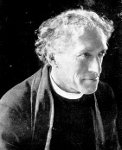
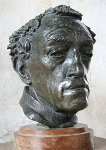 Mention Thaxted to clergy and laypeople of a certain age and tradition
and they will immediately think of the heady mix of bold left-wing
politics, self-consciously 'English' liturgy (with a nostalgia for
'merrie England' - and St George - expressed through morris and maypole
dancing), and high-quality arts and crafts and music (including plainsong) that was the
legacy of Conrad le Despenser Roden Noël (1869-1942), son of poet Roden Noël, who came from London to be the Vicar of St John the Baptist, St Mary & St Laurence Thaxted in 1910, remaining until his death in 1942. (The writer of this page recalls visiting as a
student, and seeing his former study, still with its red
walls and telephone.) But younger church folk have little awareness of
any of this - even though it is all well-documented. We include this material on our site because Thaxted was
the 'mecca' for a number of the clergy of this parish in the mid-20th
century - notably Fathers Groser, Boggis and Cuthbertson - who sought to create urban equivalents.
Mention Thaxted to clergy and laypeople of a certain age and tradition
and they will immediately think of the heady mix of bold left-wing
politics, self-consciously 'English' liturgy (with a nostalgia for
'merrie England' - and St George - expressed through morris and maypole
dancing), and high-quality arts and crafts and music (including plainsong) that was the
legacy of Conrad le Despenser Roden Noël (1869-1942), son of poet Roden Noël, who came from London to be the Vicar of St John the Baptist, St Mary & St Laurence Thaxted in 1910, remaining until his death in 1942. (The writer of this page recalls visiting as a
student, and seeing his former study, still with its red
walls and telephone.) But younger church folk have little awareness of
any of this - even though it is all well-documented. We include this material on our site because Thaxted was
the 'mecca' for a number of the clergy of this parish in the mid-20th
century - notably Fathers Groser, Boggis and Cuthbertson - who sought to create urban equivalents.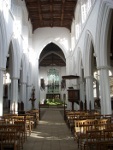

 The patron
of the parish was the Countess of Warwick, an aristocratic socialist
and feminist,
admirer and biographer of William Morris, who perhaps imagined that Noël
would use Thaxted as a base for his speaking engagements around the
country, but he had other ideas. He put this small Essex town firmly on the ecclesiastical map, and people flocked
from far and wide. Here politics and aesthetics were all of a
piece. According to The Friend, Conrad fought passionately against
hypocrisy and oppression, against the Philistine and the Puritan,
particularly the Puritan. He sought tranquillity, but it eluded one so
militant. His temperament urged him to battle even for the beauty which
he so prized in worship, no less than for the Church Socialist League.
The story of his life has much charm and contains many echoes of his
characteristic laughter. [Right: old print of the church; interior in the 1920s, and today.]
The patron
of the parish was the Countess of Warwick, an aristocratic socialist
and feminist,
admirer and biographer of William Morris, who perhaps imagined that Noël
would use Thaxted as a base for his speaking engagements around the
country, but he had other ideas. He put this small Essex town firmly on the ecclesiastical map, and people flocked
from far and wide. Here politics and aesthetics were all of a
piece. According to The Friend, Conrad fought passionately against
hypocrisy and oppression, against the Philistine and the Puritan,
particularly the Puritan. He sought tranquillity, but it eluded one so
militant. His temperament urged him to battle even for the beauty which
he so prized in worship, no less than for the Church Socialist League.
The story of his life has much charm and contains many echoes of his
characteristic laughter. [Right: old print of the church; interior in the 1920s, and today.]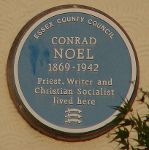 Paycockes: an Arts and Crafts setting
Paycockes: an Arts and Crafts setting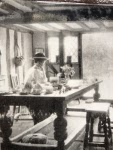
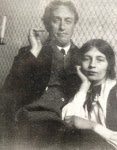 Miriam [left in her workshop; right is
Noël with their daughter Barbara] was a keen gardener, and set out the
garden in Arts and Crafts style with stepped terraces, a writing
shelter and a dovecote - and also a tennis court. The yard was covered in herringbone brickwork.
In 1923 Noël's friend Gustav Holst recuperated there after
an injury; his daughter Imogen, then 16, wrote to a school friend This
house is absolutely too wonderful for words ... it is a dream. And it is
great fun living in a dream ...The house is supposed to be the best example
of the period in the whole of England, and artists and architects make
pilgrimages from all over the country to see it. We are tremendously
proud of it, and as it isn’t our own we can swank about it to our
heart’s content.
Miriam [left in her workshop; right is
Noël with their daughter Barbara] was a keen gardener, and set out the
garden in Arts and Crafts style with stepped terraces, a writing
shelter and a dovecote - and also a tennis court. The yard was covered in herringbone brickwork.
In 1923 Noël's friend Gustav Holst recuperated there after
an injury; his daughter Imogen, then 16, wrote to a school friend This
house is absolutely too wonderful for words ... it is a dream. And it is
great fun living in a dream ...The house is supposed to be the best example
of the period in the whole of England, and artists and architects make
pilgrimages from all over the country to see it. We are tremendously
proud of it, and as it isn’t our own we can swank about it to our
heart’s content.
|
To create the demand for the Catholic Faith, the
whole Catholic Faith, and nothing but the Catholic Faith.
To encourage
the rising of the people in the might of the Risen Christ and the
Saints,
mingling Heaven and earth that we may shatter this greedy world
to bits.
|
| We must mark the sinister proposals that are being made in high places for such social reconstruction as will inevitably forbid the restoration to the poor of hard-won liberties willingly surrendered during the war ... Reconstruction without revolution is evil, for Reconstruction must be the outcome of Revolution. In the Battles that will have to be fought against the forces of death, whether frankly reactionary or masquerading as State Socialism and Social Reform, we must ally ourselves with the forces of life, and with St. Ambrose of Milan, with St. Thomas of Canterbury, with Our Lady of the Magnificat. And in the coming rebellion against the Prussians in England, Catholics will need such fiery allies to save them from the tame surrender of Nonconformist and Agnostic labour leaders, and to steel our spirits in these days when 'whoseover killeth us will think that he doeth God a service'. |
| Heaven forbid that Trade Unions should trust the leaders they elect, but Heaven forbid that they should continue to elect such leaders! Much better that the rank and file should kick over the traces than follow placemen, gas bags, puritans and lobby worms who misrepresent them, but if the rank and file had been more creative it would have produced leaders it could have followed. |
| The rich and their toadies KILLED CHRIST. Our
Rulers, the Empire, the Rich, and those who surround them Kill Him NOW.
Inasmuch as ye have done it unto the least of these (the IRISH AND THE MINERS), Ye have done it unto Me. |
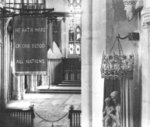 Noël wrote the
next morning to reassure Miriam (who had not stayed at home) We are still alive – it was a most exciting evening
... Jack and I nearly got done in earlier in trying to get the union
jacks down from the churchyard. Some Cork Black and Tans say they are
on their way to England to murder me at night. About murdering, I will
put it in the hands of the police, but of course they could not protect
so open a place as the vicarage. It may be bluff, but – Best love,
darling. The flags of our religion are still flying. More skirmishes followed. The flags were hung high up on the chancel arch [right: postcard of the Red Flag by Noël's sister Frances], but a consistory court ruled against his display, and he obeyed. Questions
were asked in Parliament - he was accused of sedition. Though actually Vicar, the press dubbed him 'the Red Rector'. See further Arthur Burns Beyond the 'Red Vicar': Community and Christian Socialism in Thaxted, Essex, 1910-84 (History Workshop Journal 75, Spring 2013, pp101-124).
Noël wrote the
next morning to reassure Miriam (who had not stayed at home) We are still alive – it was a most exciting evening
... Jack and I nearly got done in earlier in trying to get the union
jacks down from the churchyard. Some Cork Black and Tans say they are
on their way to England to murder me at night. About murdering, I will
put it in the hands of the police, but of course they could not protect
so open a place as the vicarage. It may be bluff, but – Best love,
darling. The flags of our religion are still flying. More skirmishes followed. The flags were hung high up on the chancel arch [right: postcard of the Red Flag by Noël's sister Frances], but a consistory court ruled against his display, and he obeyed. Questions
were asked in Parliament - he was accused of sedition. Though actually Vicar, the press dubbed him 'the Red Rector'. See further Arthur Burns Beyond the 'Red Vicar': Community and Christian Socialism in Thaxted, Essex, 1910-84 (History Workshop Journal 75, Spring 2013, pp101-124). 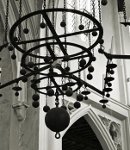
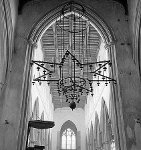
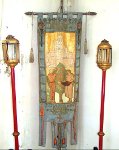 Noël sought to make his church a centre for the English crafts movement. An early acquisition (in 1910) was the Stella [two views left], a star-shaped candelabrum
hanging at the aisle crossing, designed by Randall Wells for St Mary
the Virgin Primrose Hill but never installed there. Based
on Matthew's birth narrative (1.1-17) it has 42 lights, in three
groups: for the 14 generations from Abraham to King
David, for the 14 generations from King David to the Flight into Egypt, and for the 14
generations from the Flight into Egypt to the birth of Jesus Christ in
Bethlehem, with a ball symbolising the world to which Christ brings light.
Noël sought to make his church a centre for the English crafts movement. An early acquisition (in 1910) was the Stella [two views left], a star-shaped candelabrum
hanging at the aisle crossing, designed by Randall Wells for St Mary
the Virgin Primrose Hill but never installed there. Based
on Matthew's birth narrative (1.1-17) it has 42 lights, in three
groups: for the 14 generations from Abraham to King
David, for the 14 generations from King David to the Flight into Egypt, and for the 14
generations from the Flight into Egypt to the birth of Jesus Christ in
Bethlehem, with a ball symbolising the world to which Christ brings light. 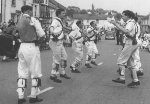
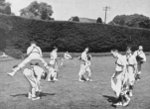
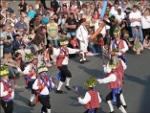
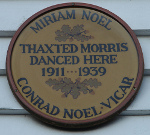
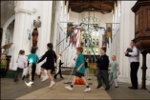 Mercifully, Noël was not squeamish (as some clergy are today) about the implied
theology of these verses; nor about the secular, and possibly
semi-pagan, associations of morris and maypole dancing.
At a time when folk arts were undergoing a revival, he positively
welcomed them into church. The Thaxted Morris was founded in 1911, and
the national Morris Ring was set up there in 1934 and still regards
Thaxted as its home - and some of its members were lifelong Tory voters! Left are two scenes in Thaxted from the 1950s plus the 75th anniversary of the Ring in 2009. Right are children from Thaxted and Great Dunmow schools maypole dancing in church for St George's Day 2010, at which they sang I vow to thee, my country to Holst's tune Thaxted, of course). By a nice touch, one of the Thaxted church bells bears the inscription I ring for the general dance.
Mercifully, Noël was not squeamish (as some clergy are today) about the implied
theology of these verses; nor about the secular, and possibly
semi-pagan, associations of morris and maypole dancing.
At a time when folk arts were undergoing a revival, he positively
welcomed them into church. The Thaxted Morris was founded in 1911, and
the national Morris Ring was set up there in 1934 and still regards
Thaxted as its home - and some of its members were lifelong Tory voters! Left are two scenes in Thaxted from the 1950s plus the 75th anniversary of the Ring in 2009. Right are children from Thaxted and Great Dunmow schools maypole dancing in church for St George's Day 2010, at which they sang I vow to thee, my country to Holst's tune Thaxted, of course). By a nice touch, one of the Thaxted church bells bears the inscription I ring for the general dance.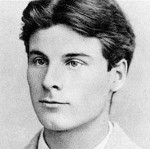
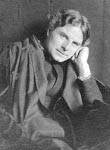
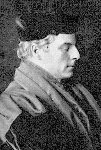
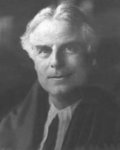
 A close friend and associate, and fellow Christian Socialist radical, was the liturgist and musicologist Percy Dearmer [left at various stages in his life and right in 'clerical streetwear' - see below]. In 1899 he published The Parson's Handbook,
which went through many editions over the next half-century and more. (The first edition, and other of his works, can be read here.)
It presented in great (and at times spurious) detail the case for a
'catholic' style of worship which he believed was faithful to - and
indeed required by - the Book of Common Prayer, and its predecessors: a
distinctively English style rather than the aping of continental Roman
Catholic patterns. It came to be termed 'Sarum use' - or, by its
detractors, 'British Museum religion' - and was widely copied. He put
this programme into action at St Mary the Virgin, Primrose Hill in
north London where he was Vicar. Every detail of how to run a
parish and its worship along these lines was spelt out: the layout and
furnishings of the (whitewashed) church, the timing of services, the
use of gas, service sheets, the apparel of the clergy and other
ministers, the ritual of every service, even down to the best
dimensions for cupboards and drawers in the vestry and recipes for blending
incense.
A close friend and associate, and fellow Christian Socialist radical, was the liturgist and musicologist Percy Dearmer [left at various stages in his life and right in 'clerical streetwear' - see below]. In 1899 he published The Parson's Handbook,
which went through many editions over the next half-century and more. (The first edition, and other of his works, can be read here.)
It presented in great (and at times spurious) detail the case for a
'catholic' style of worship which he believed was faithful to - and
indeed required by - the Book of Common Prayer, and its predecessors: a
distinctively English style rather than the aping of continental Roman
Catholic patterns. It came to be termed 'Sarum use' - or, by its
detractors, 'British Museum religion' - and was widely copied. He put
this programme into action at St Mary the Virgin, Primrose Hill in
north London where he was Vicar. Every detail of how to run a
parish and its worship along these lines was spelt out: the layout and
furnishings of the (whitewashed) church, the timing of services, the
use of gas, service sheets, the apparel of the clergy and other
ministers, the ritual of every service, even down to the best
dimensions for cupboards and drawers in the vestry and recipes for blending
incense.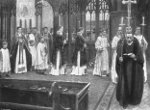





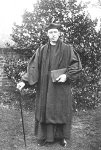 Right are
some of the plates from the 1909 edition showing this style of ritual - a procession before the
eucharist (from a painting of 1906) - and the 'correct' vesure of
clergy and other ministers: a server in alb with apparelled amice; a
clerk in a tunicle (crucifer); the sleeveless rochet (which he
recommended for those who were too lazy or inept to wear alb and
amice); a priest graduate in choir habit; and a clerk in surplice and stole
for a wedding. All these robes should be long and full: he abhorred the rage for cheapness. Before
vestments became a commercial article, they remained full, on the
Continent as well as here. Now the worship of Mammon has so far
intrenched on the honour due to God that the sweater has his own way
with us, and it is considered seemly for a minister to appear in church
in the garment called a 'sausage-skin', a so-called surplice that is
not only short, but is entirely deprived of gathers, so that a few
extra half-pence may be saved from the cost of worship. Here his Christian Socialist principles kicked in; for, as he wrote in the introduction, vulgarity in the long-run always means
cheapness, and cheapness means the tyranny of the sweater. It has
been pointed out that a modern preacher often stands in a sweated
pulpit,
wearing a sweated surplice over a suit of clothes that were not
produced under fair conditions, and, holding a sweated book in one hand,
with the other he points to the machine-made cross at the
jerry-built altar, and appeals to the sacred principles of mutual
sacrifice and
love. Right is 'the
priest in outdoor habit' - cassock, gown, scarf,
Canterbury cap. The cassock is double-breasted ('Sarum') - this was the
English style, looked better and also, as he pointed out, removed the possibility of the
priest painfully kneeling on a button in a cassock with buttons down the front.
He advocated wearing knickerbockers underneath, for comfort.
Right are
some of the plates from the 1909 edition showing this style of ritual - a procession before the
eucharist (from a painting of 1906) - and the 'correct' vesure of
clergy and other ministers: a server in alb with apparelled amice; a
clerk in a tunicle (crucifer); the sleeveless rochet (which he
recommended for those who were too lazy or inept to wear alb and
amice); a priest graduate in choir habit; and a clerk in surplice and stole
for a wedding. All these robes should be long and full: he abhorred the rage for cheapness. Before
vestments became a commercial article, they remained full, on the
Continent as well as here. Now the worship of Mammon has so far
intrenched on the honour due to God that the sweater has his own way
with us, and it is considered seemly for a minister to appear in church
in the garment called a 'sausage-skin', a so-called surplice that is
not only short, but is entirely deprived of gathers, so that a few
extra half-pence may be saved from the cost of worship. Here his Christian Socialist principles kicked in; for, as he wrote in the introduction, vulgarity in the long-run always means
cheapness, and cheapness means the tyranny of the sweater. It has
been pointed out that a modern preacher often stands in a sweated
pulpit,
wearing a sweated surplice over a suit of clothes that were not
produced under fair conditions, and, holding a sweated book in one hand,
with the other he points to the machine-made cross at the
jerry-built altar, and appeals to the sacred principles of mutual
sacrifice and
love. Right is 'the
priest in outdoor habit' - cassock, gown, scarf,
Canterbury cap. The cassock is double-breasted ('Sarum') - this was the
English style, looked better and also, as he pointed out, removed the possibility of the
priest painfully kneeling on a button in a cassock with buttons down the front.
He advocated wearing knickerbockers underneath, for comfort.
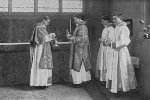

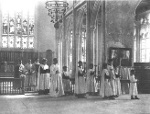 All
these principles were put into effect at Thaxted. Left is
the litany procession in the 1920s. (Right are more pictures
of Sarum-style ritual.) However, his processions were not as solemn as
they looked, for everyone joined in, including dancers if present,
carrying flowers and banners, as Noël explained in his autobiography:
All
these principles were put into effect at Thaxted. Left is
the litany procession in the 1920s. (Right are more pictures
of Sarum-style ritual.) However, his processions were not as solemn as
they looked, for everyone joined in, including dancers if present,
carrying flowers and banners, as Noël explained in his autobiography:| The revolutionary teaching at Thaxted may be
studied in books and pamphlets on sale in the church, but the Thaxted
experiment is by no means only concerned with the pulpit and the press,
but just as much with the life of a group and the expression of that
life in worship. Thaxted is becoming a place of pilgrimage for those who
are tired of the sluggish routine and conventionalism of much modern
Nonconformity and of the 'C. of E.' We are proud to claim membership in
the Church of England for she is the Church of Anselm, of Becket, of
those such as Langton and John Ball who fought for the freedom of the
people, the Church of Laud in his fight against a narrow Calvinism and
the oppression of the poor, and in still more modern times, the Church
of Maurice and Kingsley, of Scott Holland and Stewart Headlam. All this
the 'Church of England' calls to mind, but the 'C. of E.' is only
another name for the Establishment, and the Establishment is the
religion of the ratepayer, and the religion of the ratepayer is not a
religion but a disease.
Now what is there in the Thaxted worship which scandalizes the 'ratepayer' and attracts many in the town itself and many pilgrims from all quarters? Perhaps it is the homeliness and unconventionality which many people appreciate. The organ and surpliced choir no longer predominate. The processions on High Days and Holidays include not only the ceremonial group in bright vestments, but the people themselves, children with flowers and branches, women in gay veils, men with torches and banners, all this colour and movement centering round the Lord Christ present in the Eucharist. We preach the Christ Who all through His life stressed the value of the common meal, the bread and wine joyously shared among His people, the Mass as prelude to the New World Order in which all would be justly produced and distributed. The Lord thus chose the human things of everyday life, the useful bread and the genial wine, to be the perpetual vehicles of his presence among us till His kingdom should come on earth as in Heaven. But all this involves politics, and we are often rebuked for mixing politics with religion. Well! the blind following of any political party, the politics of the party hack, these are certainly not the business of the pulpit; but politics, in the wider sense of social justice, are part and parcel of the gospel of Christ and to ignore them is to be false to His teaching. Worship and beauty are not to be despised, but worship divorced from social righteousness is an abomination to God. |
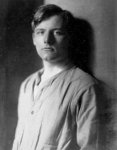 After
Primrose Hill he served as a chaplain in the First World War (in 1915
his first wife Mabel died serving with an ambulance unit in Serbia, and
his son Christopher of battle wounds), and for some years held no
ecclesiastical appointment, concentrating on lecturing (including as
professor of ecclesiastical at Kings College London) and writing; in
1931 he became a Canon of Westminster Abbey, where he ran a canteen for
the unemployed. He died in 1936. See further Donald Gray (one of his
successors at the Abbey) Percy Dearmer - A Parson's Pilgrimage (Canterbury Press 2000). His other son Geoffrey Dearmer LVO also served in the war [right in 1918] and was a distinguished poet (and also a hymn writer - as few remain in use). Between
the wars he worked as a censor of plays for the Lord Chamberlain
(despite being uncensorious by nature), and for the BBC as talent scout
for religious programmes, and editor of Children's Hour, broadcasting
until the 1950s as 'Uncle Geoffrey'. He lived to the age of 103 and
died in 1996.
After
Primrose Hill he served as a chaplain in the First World War (in 1915
his first wife Mabel died serving with an ambulance unit in Serbia, and
his son Christopher of battle wounds), and for some years held no
ecclesiastical appointment, concentrating on lecturing (including as
professor of ecclesiastical at Kings College London) and writing; in
1931 he became a Canon of Westminster Abbey, where he ran a canteen for
the unemployed. He died in 1936. See further Donald Gray (one of his
successors at the Abbey) Percy Dearmer - A Parson's Pilgrimage (Canterbury Press 2000). His other son Geoffrey Dearmer LVO also served in the war [right in 1918] and was a distinguished poet (and also a hymn writer - as few remain in use). Between
the wars he worked as a censor of plays for the Lord Chamberlain
(despite being uncensorious by nature), and for the BBC as talent scout
for religious programmes, and editor of Children's Hour, broadcasting
until the 1950s as 'Uncle Geoffrey'. He lived to the age of 103 and
died in 1996.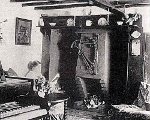
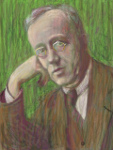 Gustav Holst (1874-1934)
had a house in or around Thaxted from 1914, and became a close friend
of Noël. He regularly played the organ for the Sunday Mass (and his
daughter Imogen - right in their cottage - the cello), and they put on Whitsuntide concerts which were the origin of the Thaxted Festival.
It was here that he wrote his 'Seven Pieces for Large Orchestra' which
later became known as the Planets Suite. The melody from 'Jupiter'
became the hymn-tune Thaxted, for I vow to thee, my country
(and various less-nationalistic rewrites): when the BBC used it for the
Rugby World Cup as 'World in Union' the royalties went to the church.
His other famous hymn tune is Cranham, for Christina Rossetti's in the bleak mid-winter (a strong rival to Harold Darke's peerless choral setting). Here are more details of his Thaxted connections.
Gustav Holst (1874-1934)
had a house in or around Thaxted from 1914, and became a close friend
of Noël. He regularly played the organ for the Sunday Mass (and his
daughter Imogen - right in their cottage - the cello), and they put on Whitsuntide concerts which were the origin of the Thaxted Festival.
It was here that he wrote his 'Seven Pieces for Large Orchestra' which
later became known as the Planets Suite. The melody from 'Jupiter'
became the hymn-tune Thaxted, for I vow to thee, my country
(and various less-nationalistic rewrites): when the BBC used it for the
Rugby World Cup as 'World in Union' the royalties went to the church.
His other famous hymn tune is Cranham, for Christina Rossetti's in the bleak mid-winter (a strong rival to Harold Darke's peerless choral setting). Here are more details of his Thaxted connections. 
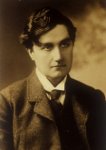 Two other musicians who regularly visited Thaxted were Ralph Vaughan Williams (1872-1958) - left -
who also regularly played the organ [currently in
restoration], and collaborated with Holst on the collection of
folksongs, and Martin Shaw (1875-1958) - right.
As noted above, Vaughan Williams and Shaw collaborated with Percy
Dearmer on hymnals. Martin Shaw is perhaps best remembered for his fine Anglican Folk Mass
('founded on native hymn melodies') which he wrote in 1918 for St Mary
Primrose Hill and was widely sung (it adapts readily to contemporary-langugage texts); he also adapted the
old melody Bunessan (for Eleanor Farjeon's words Morning has broken) and wrote Little Cornard [a nearby village] for Hills of the north rejoice, and Marching for Through the night of doubt and sorrow.
Two other musicians who regularly visited Thaxted were Ralph Vaughan Williams (1872-1958) - left -
who also regularly played the organ [currently in
restoration], and collaborated with Holst on the collection of
folksongs, and Martin Shaw (1875-1958) - right.
As noted above, Vaughan Williams and Shaw collaborated with Percy
Dearmer on hymnals. Martin Shaw is perhaps best remembered for his fine Anglican Folk Mass
('founded on native hymn melodies') which he wrote in 1918 for St Mary
Primrose Hill and was widely sung (it adapts readily to contemporary-langugage texts); he also adapted the
old melody Bunessan (for Eleanor Farjeon's words Morning has broken) and wrote Little Cornard [a nearby village] for Hills of the north rejoice, and Marching for Through the night of doubt and sorrow.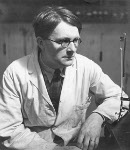 A regular visitor from Cambridge and supporter of the 'Thaxted project' was Professor Joseph Needham CH FRS FBA (1900-95 - right in
1937), a much-honoured biochemist who became the leading world authority on
Chinese science and medicine; he espoused a particular style of
Christian socialism and was a communist sympathiser. He and his wife
Dorothy (he also had a long-term relationship with Lu Gwei-Djen) were
devotees of gymnosophy
- naked exercising in the tradition of Hindu 'naked philosophers',
which was taken up in Germany and elsewhere between the wars - but this
does not appear to have been added to the Thaxted programme...
The Needham Research Institute has more on his life and achievements.
A regular visitor from Cambridge and supporter of the 'Thaxted project' was Professor Joseph Needham CH FRS FBA (1900-95 - right in
1937), a much-honoured biochemist who became the leading world authority on
Chinese science and medicine; he espoused a particular style of
Christian socialism and was a communist sympathiser. He and his wife
Dorothy (he also had a long-term relationship with Lu Gwei-Djen) were
devotees of gymnosophy
- naked exercising in the tradition of Hindu 'naked philosophers',
which was taken up in Germany and elsewhere between the wars - but this
does not appear to have been added to the Thaxted programme...
The Needham Research Institute has more on his life and achievements.Back to St John Beverley Groser | Back to Jack Boggis | Back to Hugh Cuthbertson | Back to About Us